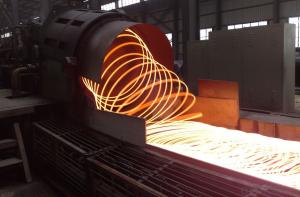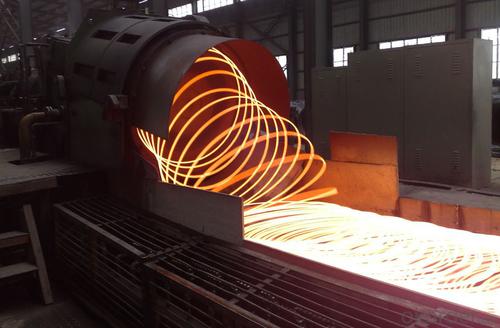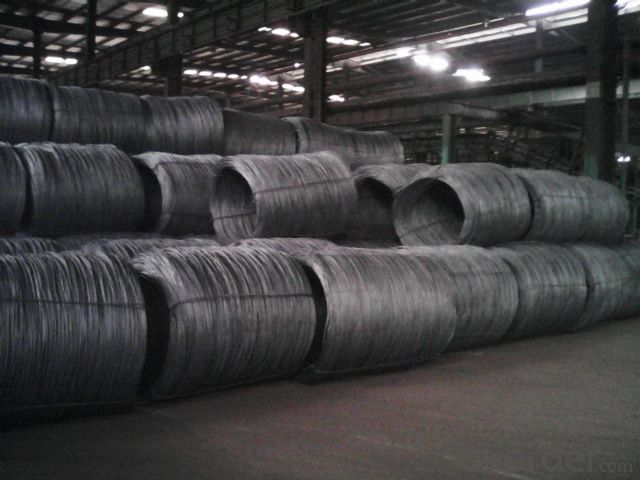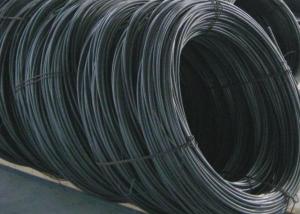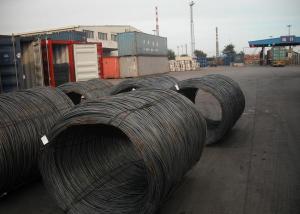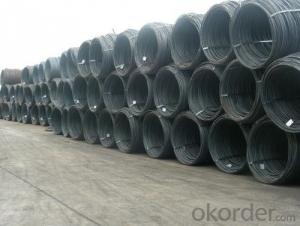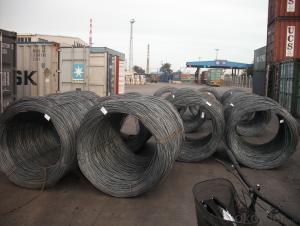Hot Rolled Low Carbon Steel Wire Rod
- Loading Port:
- China Main Port
- Payment Terms:
- TT or LC
- Min Order Qty:
- 100 m.t.
- Supply Capability:
- 10000 m.t./month
OKorder Service Pledge
OKorder Financial Service
You Might Also Like
Product Description:
OKorder is offering Hot Rolled Low Carbon Steel Wire Rod at great prices with worldwide shipping. Our supplier is a world-class manufacturer of steel, with our products utilized the world over. OKorder annually supplies products to African, South American and Asian markets. We provide quotations within 24 hours of receiving an inquiry and guarantee competitive prices.
Product Applications:
Hot Rolled Low Carbon Steel Wire Rod are ideal for structural applications and are widely used in the construction of buildings and bridges, and the manufacturing, petrochemical, and transportation industries.
Product Advantages:
OKorder's Hot Rolled Low Carbon Steel Wire Rod are durable, strong, and wide variety of sizes.
Main Product Features:
· Premium quality
· Prompt delivery & seaworthy packing (30 days after receiving deposit)
· Can be recycled and reused
· Mill test certification
· Professional Service
· Competitive pricing
Product Specifications:
Steel Grade: Q195/235, SAE1006-1018B
Standard: ASTM, GB
Diameter: 5.5mm, 6.5mm, 7mm,8mm,9mm,10mm,12mm,14mm
Type: in coil, coil weight around 2MT
Alloy or Not: Alloy
Technique: Hot Rolled
Place of Origin: China Mainland
Surface: round, no twisted, light and smooth
Grade | Chemical Composition(%) | |||||
C | Mn | Si | S | P | B | |
SAE1006B | 0.03~O.07 | ≤0.32 | ≤0.30 | ≤0.045 | ≤0.040 | >0.0008 |
Mechanical properties | ||||||
Yield strength(N/mm2) | Tensile strength(N/mm2) | Elongation(%) | ||||
250-280 | 350-380 | ≥32 | ||||
Grade | Chemical Composition(%) | |||||
C | Mn | Si | S | P | B | |
SAE1008B | 0.10max | 0.3~O.50 | 0.15max | 0.050max | 0.040 max | 0.0008 min |
Mechanical properties | ||||||
Yield strength(N/mm2) | Tensile strength(N/mm2) | Elongation(%) | ||||
≥195 | 315-430 | ≥30 | ||||
Grade | Chemical Composition(%) | |||||
C | Mn | Si | S | P | B | |
Q195B | 0.06~O.12 | 0.25~O.50 | ≤0.30 | ≤0.050 | ≤0.045 | >0.0008 |
Mechanical properties | ||||||
Yield strength(N/mm2) | Tensile strength(N/mm2) | Elongation(%) | ||||
≥195 | 315-430 | ≥33 | ||||
Grade | Chemical Composition(%) | |||||
C | Mn | Si | S | P | B | |
Q235B | 0.12~O.2 | 0.3~O.701 | ≤0.30 | ≤0.045 | ≤0.045 | >0.0008 |
Mechanical properties | ||||||
Yield strength(N/mm2) | Tensile strength(N/mm2) | Elongation(%) | ||||
235 | 375-500 | ≥26 | ||||
FAQ:
Q1: Why buy Materials & Equipment from OKorder.com?
A1: All products offered byOKorder.com are carefully selected from China's most reliable manufacturing enterprises. Through its ISO certifications, OKorder.com adheres to the highest standards and a commitment to supply chain safety and customer satisfaction.
Q2: How do we guarantee the quality of our products?
A2: We have established an advanced quality management system which conducts strict quality tests at every step, from raw materials to the final product. At the same time, we provide extensive follow-up service assurances as required.
Q3: How soon can we receive the product after purchase?
A3: Within three days of placing an order, we will arrange production. The normal sizes with the normal grade can be produced within one month. The specific shipping date is dependent upon international and government factors, the delivery to international main port about 45-60days.
Images:
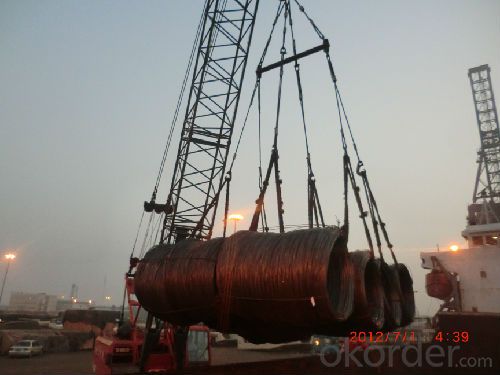
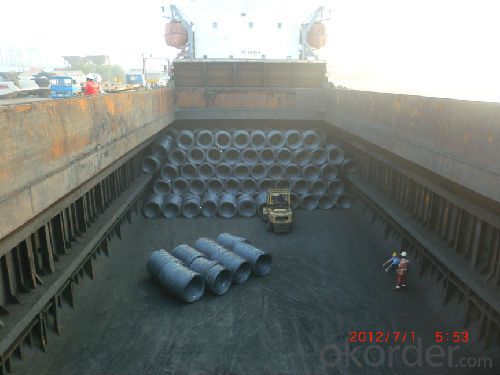
- Q: What are the different types of coatings for steel wire rod?
- There are several different types of coatings that can be applied to steel wire rods to enhance their performance and protect them from corrosion. Some of the commonly used coatings include: 1. Zinc Coating: Zinc coating, also known as galvanization, is one of the most popular coatings for steel wire rods. It provides excellent corrosion resistance and can be applied through hot-dip galvanizing or electroplating methods. 2. Polymer Coating: Polymer coatings are often used to provide additional protection against corrosion and abrasion. These coatings can be applied by dip coating, extrusion, or powder coating methods, and they offer good adhesion and flexibility. 3. Phosphate Coating: Phosphate coatings are commonly used as a pre-treatment on steel wire rods before applying other coatings. They enhance the adhesion of subsequent coatings and improve corrosion resistance. 4. Epoxy Coating: Epoxy coatings are known for their excellent adhesion and chemical resistance. They are often used in industrial settings where the wire rods are exposed to harsh environments or corrosive substances. 5. Powder Coating: Powder coatings offer a durable and decorative finish to steel wire rods. These coatings are applied as a dry powder and then cured under heat to create a smooth, protective layer. 6. Organic Coating: Organic coatings, such as acrylics or polyurethanes, are often used for aesthetic purposes or to provide a specific color to the wire rods. These coatings also offer some degree of protection against corrosion. 7. Ceramic Coating: Ceramic coatings are used in high-temperature applications where the wire rods are exposed to extreme heat or thermal cycling. These coatings provide excellent heat resistance and can withstand thermal shocks. It's important to choose the appropriate coating based on the specific requirements and intended use of the steel wire rods. Different coatings offer varying levels of protection, durability, and resistance to specific environmental factors.
- Q: What are the different types of steel wire rod defects that can occur during wire drawing?
- There are several types of steel wire rod defects that can occur during wire drawing. Some common defects include surface cracks, internal cracks, surface abrasion, surface defects such as pits or scales, improper dimensions, and uneven surface finish. These defects can negatively affect the quality and performance of the wire, leading to potential failures or reduced strength.
- Q: How is steel wire rod used in the manufacturing of wire for shipbuilding applications?
- Steel wire rod is used in the manufacturing of wire for shipbuilding applications as it serves as the primary raw material for producing high-quality wires. This wire rod is first drawn through a series of dies to reduce its diameter and increase its length, resulting in a thinner and longer wire. This wire is then further processed and fabricated into various components such as cables, ropes, and structural elements used in shipbuilding. The strength and durability of steel wire rod make it an ideal material for withstanding the harsh marine environment and ensuring the safety and reliability of ships.
- Q: How is steel wire rod used in the manufacturing of wire springs?
- Steel wire rod is used in the manufacturing of wire springs as it serves as the primary raw material. The wire rod is first drawn through a series of dies to reduce its diameter and increase its length, ultimately forming the desired spring wire. This wire is then coiled, bent, or shaped into various configurations to create wire springs, which are widely used in industries such as automotive, construction, and appliances for their strength and flexibility.
- Q: How is steel wire rod used in the manufacturing of wire forms for signage?
- Steel wire rod is used in the manufacturing of wire forms for signage as it provides strength and durability to the final product. The wire rod is first shaped into the desired form, such as letters or shapes, and then further processed to ensure smoothness and uniformity. This wire form is then used as the base to attach various materials like lights, acrylic panels, or vinyl, allowing for the creation of intricate and eye-catching signage designs.
- Q: What are the main factors affecting the market policies of steel wire rod?
- The main factors affecting market policies of steel wire rod include supply and demand dynamics, global economic conditions, trade policies and regulations, technological advancements, pricing trends, and competition within the industry. Additionally, factors such as raw material availability, environmental regulations, and government policies related to infrastructure development and manufacturing also play a significant role in shaping market policies for steel wire rod.
- Q: Can steel wire rod be used in the production of automotive parts?
- Indeed, automotive parts can be produced using steel wire rod. The manufacturing of diverse automotive components frequently relies on steel wire rod due to its robustness, endurance, and adaptability. It is employed in the creation of springs, cables, fasteners, reinforcements, and suspension components. Steel wire rod is renowned for its exceptional mechanical properties and remarkable tensile strength, rendering it an optimal substance for automotive applications where dependability and sturdiness are paramount. Moreover, steel wire rod can be effortlessly shaped and crafted into various dimensions and configurations, thereby rendering it appropriate for a wide array of automotive part production techniques.
- Q: How is steel wire rod used in the production of wire mesh?
- Steel wire rod is an essential component in the production of wire mesh. Wire mesh, also known as wire cloth or wire fabric, is a versatile material that is used in various industries for different purposes. The production of wire mesh begins with the manufacturing of steel wire rod. Steel wire rod is produced through a process called hot rolling, where molten steel is passed through a series of rollers to form a long, continuous rod with a specific diameter. The diameter of the steel wire rod can vary depending on the desired end product and application of the wire mesh. Once the steel wire rod is produced, it is then drawn through a series of dies to reduce its diameter further. Drawing the wire rod through these dies not only reduces its diameter but also improves its tensile strength and surface finish. This drawn wire is now ready to be used in the production of wire mesh. The steel wire rod is fed into a wire mesh machine, where it goes through a series of processes to form the wire mesh. The wire is first straightened and then cut into the desired length. These cut lengths of wire are then fed into a weaving machine, where they are interwoven to form the mesh pattern. The wire mesh machine uses various techniques to create different types of wire mesh, such as plain weave, twill weave, or Dutch weave. The steel wire rod acts as the building blocks for these patterns, providing the strength and durability needed for the wire mesh to withstand various applications. Once the wire mesh is woven, it undergoes further processes, such as galvanizing or coating, to enhance its properties. Galvanizing involves coating the wire mesh with a layer of zinc to protect it from corrosion, while coating can provide additional properties like resistance to heat, chemicals, or abrasion. In summary, steel wire rod is a crucial material in the production of wire mesh. It is used as the starting material, which is then processed and woven to create various types of wire mesh patterns. The steel wire rod provides the necessary strength and durability for the wire mesh to be used in different industries and applications.
- Q: What are the different types of steel wire rod wire drawing lubricants?
- There are various types of steel wire rod wire drawing lubricants, including dry lubricants, oil-based lubricants, and water-based lubricants. Dry lubricants are typically a mixture of graphite and other solid lubricants, which reduce friction during the wire drawing process. Oil-based lubricants are formulated with mineral or synthetic oils, providing excellent lubricity and reducing heat generation. Water-based lubricants are composed of water and additives like emulsifiers, rust inhibitors, and lubricating agents, offering good cooling and lubrication properties during wire drawing.
- Q: How is steel wire rod used in the manufacturing of wire forms for garage doors?
- Steel wire rod is used in the manufacturing of wire forms for garage doors as it provides strength, durability, and flexibility required for supporting and operating the door. The wire rod is first shaped and bent into various forms such as springs, cables, and hinges, which are essential components of a garage door system. These wire forms help in the smooth movement and proper functioning of the door, ensuring its stability and longevity.
Send your message to us
Hot Rolled Low Carbon Steel Wire Rod
- Loading Port:
- China Main Port
- Payment Terms:
- TT or LC
- Min Order Qty:
- 100 m.t.
- Supply Capability:
- 10000 m.t./month
OKorder Service Pledge
OKorder Financial Service
Similar products
Hot products
Hot Searches
Related keywords
